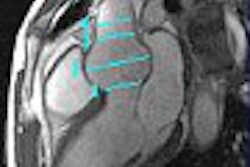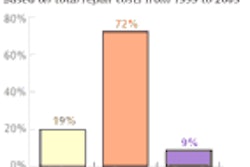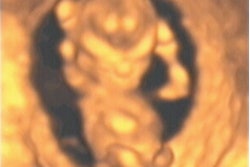Typhoid fever is endemic in India, being the fifth most common infectious disease in the country. The Widal test is the most commonly used method of detecting the disease, but does not provide results until a week after it’s administered due to the need for enough antibodies to develop to render a positive result.
Ultrasound could fill the gap and assume a role in the early detection of typhoid, according to results presented at the IRIA show by Dr. Sheena Saleem of PDS Children’s Hospital and General Hospital in Hyderabad.
Saleem’s group studied 80 patients between August 1995 and August of 2002, with each patient receiving two sets of scans. At the time of the first scan Widal results were not available, but ultimately all of the cases included in the study had positive Widal results.
Abdominal ultrasound studies were conducted within three days of clinically and serologically positive typhoid, and salmonella culture was positive in only 40% of cases. Two types of transducers were used: A convex 3.5-5 MHz transducer and a high-frequency 6-12 MHz small-parts linear transducer. Scans were repeated after four days.
The group concentrated on bowel-wall thickening, from the outer margin of the inner hyperechoic layer to the outer hyperechoic layer. They also examined the ileocecal valve, the terminal cecum, terminal ileum, colon, and mesenteric lymph nodes.
In all 80 cases, the patients had diffuse enlargement of the spleen, while thickening of the terminal ileum and cecum was present in 53 cases. Multiple ulcerations of the gallbladder wall were seen, as were multiple enlarged lymph nodes (n=55, mean=18 mm).
Other findings included hepatomegaly with normal parenchymal echotexture (n=22), thickened gall bladder (n=2), biliary sludge (n=8), positive ultrasound Murphy sign (n=14), pericholecystic edema with increased vascularity (n=8), ileal thickening of 9 mm (n=12), ileal perforation (n=1), and colon thickening (n=3).
Saleem concluded by stating that ultrasound findings of hepatomegaly, splenomegaly, ileal and cecal thickening, multiple mesenteric nodes, and thick-walled gallbladder are diagnostic features of typhoid. Ultrasound can be a noninvasive, economical, and a reasonably sensitive tool for diagnosing typhoid when serology is equivocal and cultures are negative, she said.
By Brian Casey
AuntMinnie.com staff writers
March 12, 2004
Related Reading
Ultrasound helpful in dengue fever diagnosis, December 18, 2003
3-D ultrasound offers reliable assessment of gallbladder, bile ducts, May 5, 2003
Ultrasound separates galactoceles from simple cysts, April 9, 2002
Radiology in the shadow of Kilimanjaro, April 17, 2000
Copyright © 2004 AuntMinnie.com



















